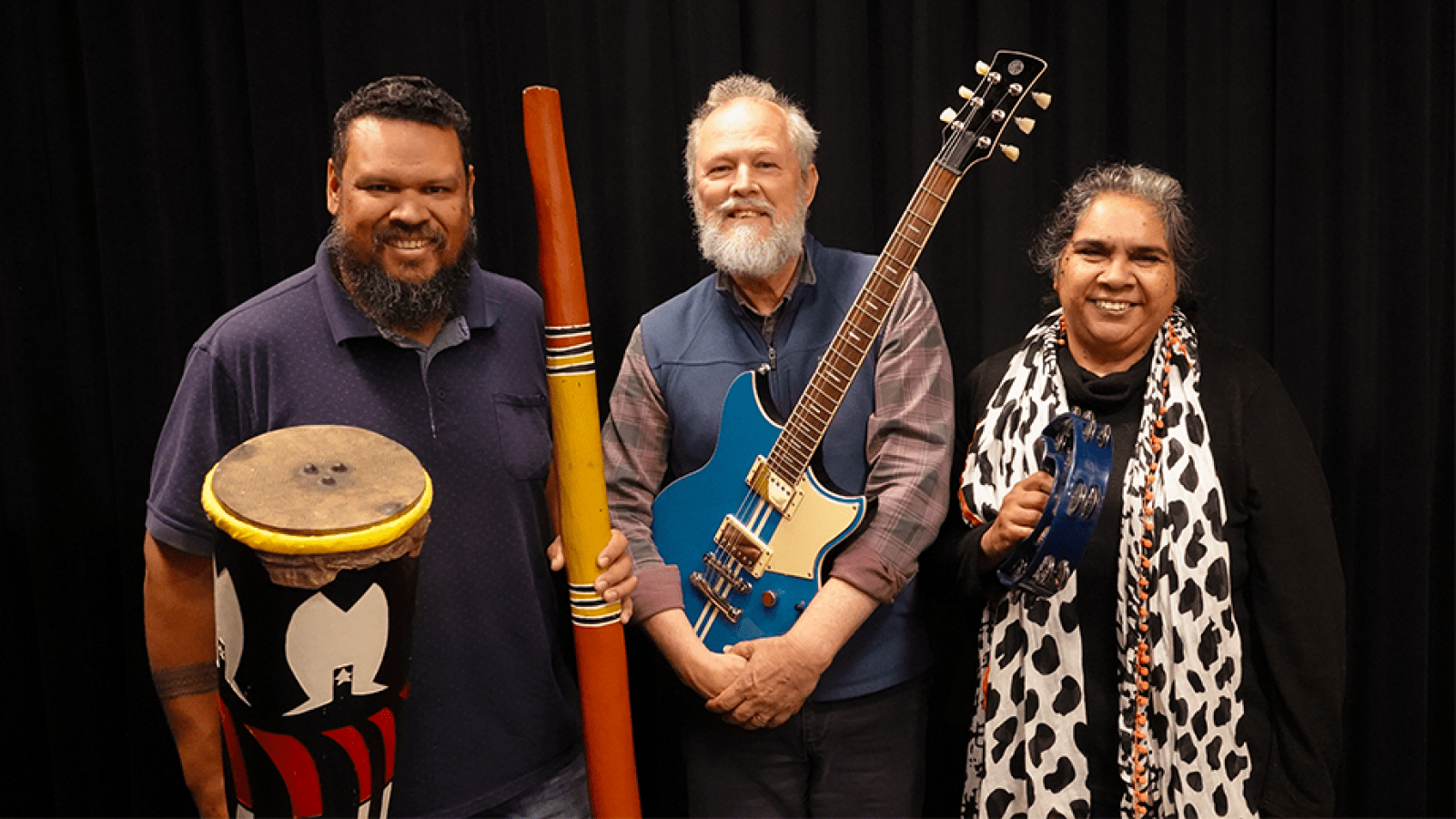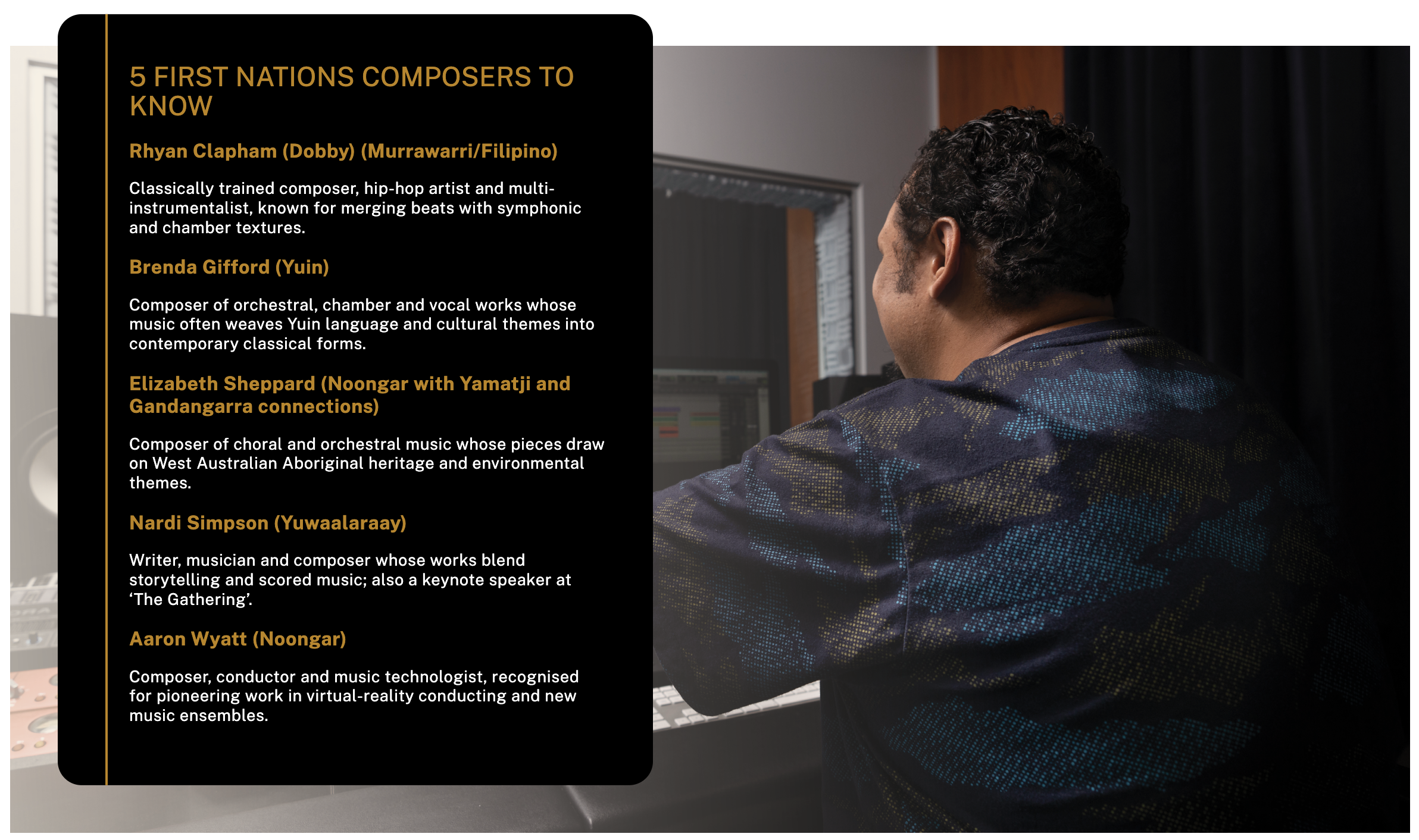Name a First Nations Composer. Many of You Can’t. But that’s about to change.

From left to right: Will Kepa, Christopher Sainsbury, Brenda Gifford.
Image: Erika McGown/ANU.
Most Australians can name First Nations actors, authors, or visual artists, but far fewer could name a First Nations composer working in classical or new music. Yet over the past decade, this field has quietly flourished, with Indigenous composers writing works for the piano, chamber ensembles and orchestras that now feature in major festivals and concert halls.
Later this year, that momentum takes centre stage at ‘The Gathering’, hosted by the ANU School of Music from 27–29 November, bringing together First Nations composers from Australia and our Pacific neighbours. Unlike a songwriter’s showcase, this event is dedicated to composers of scored music, artists who inscribe their creativity onto the page, expanding Indigenous storytelling into spaces audiences might usually associate with Beethoven.
Foundations: Ngarra-burria First Peoples Composers Program
Much of this growth stems from the internationally awarded Ngarra-burria First Peoples Composers Program. Its name, meaning “to listen, to sing” in Dharug, reflects its role in nurturing new voices. Since 2016, Ngarra-burria has mentored dozens of composers including 2025 ARIA award winner Rhyan Clapham (DOBBY) (Murrawarri/Filipino), Brenda Gifford (Yuin), Nardi Simpson (Yuwaalaraay), Elizabeth Sheppard (Noongar with Yamatji and Gandangarra connections) and Aaron Wyatt (Noongar), who now work to contribute works to ensembles across the country. Their compositions are reshaping Australia’s musical identity through cross-cultural innovation.

Program founder Professor Christopher Sainsbury, and member of the Dharug people, explains that the initiative was designed to give First Nations composers genuine entry points into an industry that has historically excluded them. “Many non-Indigenous composers have referenced Indigenous music, culture, themes or narratives in their compositions. At times, some have done so effectively, disempowering Indigenous composers. This has occurred for many decades”, he pointed out in a 2019 Platform Paper Quarterly essay.
Yil Lull Studio
The Yil Lull Studio is more than a recording space. Led by producer Will Kepa and supported through the University’s Indigenous Health and Wellbeing Grand Challenge, it brings professional music-making within reach of First Nations artists and community groups. In recent years it has hosted acts from the Djinama Yilaga Choir to Warren H Williams, supporting projects that speak to land rights, language revival, and mental health.
The studio also anchors the Space to Create residency in partnership with Creative Australia, giving emerging Indigenous musicians pathways into the national industry.
Residencies & Fellowships
The Indigenous H.C. Coombs Creative Arts Fellowship offers another platform for sustained creative work. To ensure equal representation across disciplines, the Fellowship follows a three-year cycle rotating between music, visual arts, and writing/performance. Last year's recipient, acclaimed singer-songwriter Dr Shellie Morris AO, brought her internationally recognised collaborations with remote communities into the heart of the School. This year, the Fellowship has been awarded to acclaimed artist Dennis Golding, who will continue the cycle by representing visual arts.
Community Roots: Wamburang Women’s Choir
The Wamburang Women’s Choir, based at the School of Music’s Community Music Centre, is another initiative where music strengthens cultural connection. “Wamburang” is a Ngunnawal language word meaning ‘black cockatoo’, and the choir provides a welcoming space for Indigenous women of all ages and backgrounds to come together.
Alongside building confidence and community, the choir also helps preserve and celebrate First Nations languages and stories through song. Their performances in Canberra and beyond show how community choirs can be a powerful vehicle for both cultural expression and cross-cultural understanding.
Reshaping the Field
The ANU School of Music is not only supporting individual artists but reshaping the field itself, creating space for First Nations composers, singers, and communities across every level of practice.
This journey has not been without its challenges. Building pathways into industries that have historically excluded Indigenous voices takes persistence, and the work is ongoing. Yet it is the determination and resilience of artists, academics, and the community that has propelled these initiatives forward. The School acknowledges that much remains to be done, but its commitment to lasting impact is unwavering.
‘The Gathering’ will extend this work, offering First Nations composers a national platform to share stories that speak to identity, Country, and cultural continuity. It signals a future where Indigenous voices in scored music are not just emerging, but central to how Australia hears itself.
The original article was published by the ANU College of Arts & Social Sciences and written by Erika McGown.